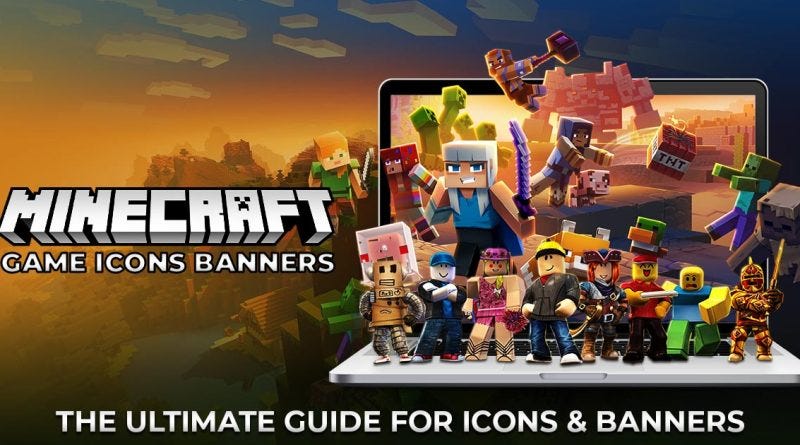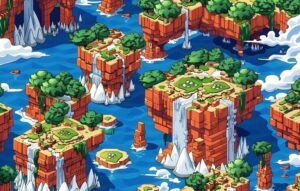Entertainment
Minecraft (2009) Game Icons and Banners: A Deep Dive into Visual Representation
Published
2 months agoon
By
Admin
Released in 2009, Minecraft has become one of the most beloved and influential video games of all time. The game, created by Markus Persson, puts players in a sandbox setting where they can gather resources, erect buildings, and endure in a world made of blocks. A key aspect of Minecraft‘s charm is its simplistic, pixelated aesthetic, which extends to every element in the game—including icons and banners. These visual elements are integral to both gameplay and customization, providing players with ways to express creativity while also serving functional purposes.
In this article, we will explore the importance and versatility of Minecraft game icons and banners, diving into how they function in the game, the ways they contribute to player identity, and their broader impact on Minecraft‘s culture.
The Importance of Icons in Minecraft

Icons in Minecraft are essential visual elements that represent different items, tools, and blocks. These small, pixelated images may seem simple, but they are crucial for a player’s interaction with the game world.
1. Item Icons
Every item in Minecraft has its own unique icon. These icons are part of the game’s user interface (UI) and appear in the inventory screen, crafting grid, and other parts of the HUD (heads-up display). Items such as swords, pickaxes, food, and blocks all have distinct icons that help players recognize them quickly. While the style is minimalistic, the icons are rich in detail relative to the blocky environment.
Functional Value: Item icons serve as visual shortcuts. Whether you’re crafting a tool, building a structure, or managing resources, the icons simplify the process by providing quick and clear identification of what you’re using.
Aesthetic Contribution: In addition to being functional, the icons have a nostalgic charm. Their pixelated, low-resolution design reflects the retro gaming era, contributing to Minecraft‘s unique aesthetic identity.
2. Mob Icons
Minecraft also features icons for mobs (mobile entities), including friendly creatures like cows and hostile mobs such as zombies and creepers. While these icons are less commonly interacted with compared to item icons, they still play a role in various mods, tools, and add-ons that players use outside the main game. For instance, third-party applications that help track mob spawning or manage in-game assets often display mob icons for easy identification.
3. Interface Icons
Icons are also present in various parts of Minecraft’s UI, such as health, hunger, and armor indicators. These symbols are easily recognizable and essential for monitoring a player’s survival status. Over time, these icons have become iconic (pun intended) representations of the Minecraft experience.
Banners: Customizable Crests for Player Expression
Banners in Minecraft represent a more dynamic form of visual customization. Introduced in version 1.8, banners are decorative blocks that can be placed on the ground or walls or used to craft shields. They are entirely customizable, allowing players to create unique designs by layering patterns and colors. This system provides a way for players to represent themselves or their groups with a personalized emblem.
1. Crafting banners
Banners are made from wool and a stick, and players can customize them using dye. The combination of different dyes and patterns enables players to create countless variations, making banners an outlet for artistic expression.
Patterns and Symbols: There are multiple base patterns that can be applied to banners, including stripes, crosses, gradients, and borders. Additionally, specific items can be used to create special patterns. For example, adding an enchanted golden apple creates a Mojang logo, while using a creeper head produces a creeper face pattern.
2. Functional Uses of Banners
While primarily decorative, banners also have functional uses in Minecraft:
- Navigation and Mapping: Banners can be named and placed on the map, giving players a way to mark important locations such as home bases, villages, or mines. This adds a layer of utility to their aesthetic value.
- Shield Customization: Banners can be applied to shields, allowing players to carry their customized banner into battle. This feature not only enhances combat visuals but also strengthens the player’s sense of identity within the game.
3. Community and multiplayer significance
In multiplayer settings, banners take on a deeper significance. They are often used to represent factions, teams, or nations within large multiplayer servers. Players can rally behind a specific banner design, giving it the same value as a real-world flag or emblem. This communal aspect of banners strengthens the social fabric of Minecraft, encouraging collaboration, competition, and creativity.
4. Banners in Adventure Maps and Role-Playing
Custom banners also play a significant role in the creation of adventure maps and role-playing scenarios. Players or map creators can design banners that align with the themes of their worlds, such as medieval kingdoms, futuristic cities, or pirate coves. These banners help to immerse players in the lore and story of the game, contributing to world-building and narrative development.
Icons and Banners in the Modding Community

Minecraft’s extensive modding community has embraced icons and banners, creating new ways to customize and interact with these elements. Mods allow players to introduce custom icons and banner patterns into their game, going beyond the default designs provided by Mojang.
1. Custom icon packs
There are numerous texture and resource packs available that replace the standard Minecraft icons with new ones. Players can download packs that align with specific themes, such as medieval, futuristic, or fantasy designs. This level of customization helps to keep the game fresh, even for players who have been playing for years.
2. Expanded Banner Customization
Mods like Optifine or Banner Additions enhance the banner creation process by allowing even more intricate designs and patterns. This gives players who love customization an extra layer of control over their in-game identity and aesthetic.
3. Integration with Skins and Builds
Many players choose to integrate banners and icons into their broader visual theme. For instance, players might design a banner that complements their skin or building style. This integration extends to icons, where players might choose resource packs that match their architectural style or personal preference.
Cultural Impact and Legacy
The simplicity of Minecraft icons and banners belies their deep impact on the game’s culture. These visual elements have become iconic in the gaming community. Minecraft’s minimalistic yet functional design has inspired countless fan artworks, merchandise, and even real-world creations.
1. Fan art and merchandise
The game’s icons, especially iconic ones like the diamond pickaxe or creeper face, have transcended the screen to appear on t-shirts, posters, and other merchandise. Likewise, popular banner designs from servers or players have become symbols of gaming subcultures.
2. Streamers and Content Creators
A considerable amount of content created by YouTubers and streamers makes use of symbols and banners. Many content creators build elaborate worlds or participate in server-wide events where custom banners represent factions or alliances. These visual markers often become memorable parts of long-running series, strengthening the connection between the audience and the gameplay.
Conclusion
Icons and banners may seem like small components of the larger Minecraft experience, but they hold significant importance in terms of both functionality and creative expression. From the practical use of item icons to the personalized designs of banners, these visual elements contribute to the overall charm and depth of the game. Whether you’re a solo builder creating a world of your own or part of a massive multiplayer faction, the ability to customize and identify with icons and banners enhances the game’s immersion and enjoyment.
As Minecraft continues to evolve, the role of icons and banners will likely expand, offering players even more ways to express themselves in this ever-growing digital landscape.
ARK: Survival Evolved Game Icons and Banners

cute:i1cdycptg50= drawings

Understanding New York Sports Club Membership: What It Offers and What Affects the Cost

Safety Tips for Compressed Air Dryers

drawing:23vyczbybxu= billie eilish

drawing:056aoyw74ce= rick and morty

drawing:4oyh4y0aqsa= santa claus

24 Hour Fitness Cost: How Much Is 24 Hour Fitness Membership?

drawing:7barsug8u0w= spider man

drawing:_ckgvun2dpk= flower

How can online food delivery sales increase and attract the maximum number of customers in 2023?

MEP BIM: Revolutionizing Building Infrastructure Design

Revolutionizing Industries with ChatGPT

Resolving the Israeli-Palestinian Conflict: A Comprehensive Analysis

Skillful Passion: Wisconsin’s Dominant Volleyball Team

Virtual Reality Rental: A Futuristic Experience

Negin Behazin vs Dignity Health: Comprehensive Comparison

Unlocking the Potential of cryptonewzhub.com Internet

iPhone 14 Pro Max: Unveiling the Next Level Innovation

Unraveling the Mystery: Robert Card’s Tragic Passing
ARK: Survival Evolved Game Icons and Banners

cute:i1cdycptg50= drawings

Understanding New York Sports Club Membership: What It Offers and What Affects the Cost

Safety Tips for Compressed Air Dryers

drawing:23vyczbybxu= billie eilish

drawing:056aoyw74ce= rick and morty

drawing:4oyh4y0aqsa= santa claus

24 Hour Fitness Cost: How Much Is 24 Hour Fitness Membership?

drawing:7barsug8u0w= spider man



